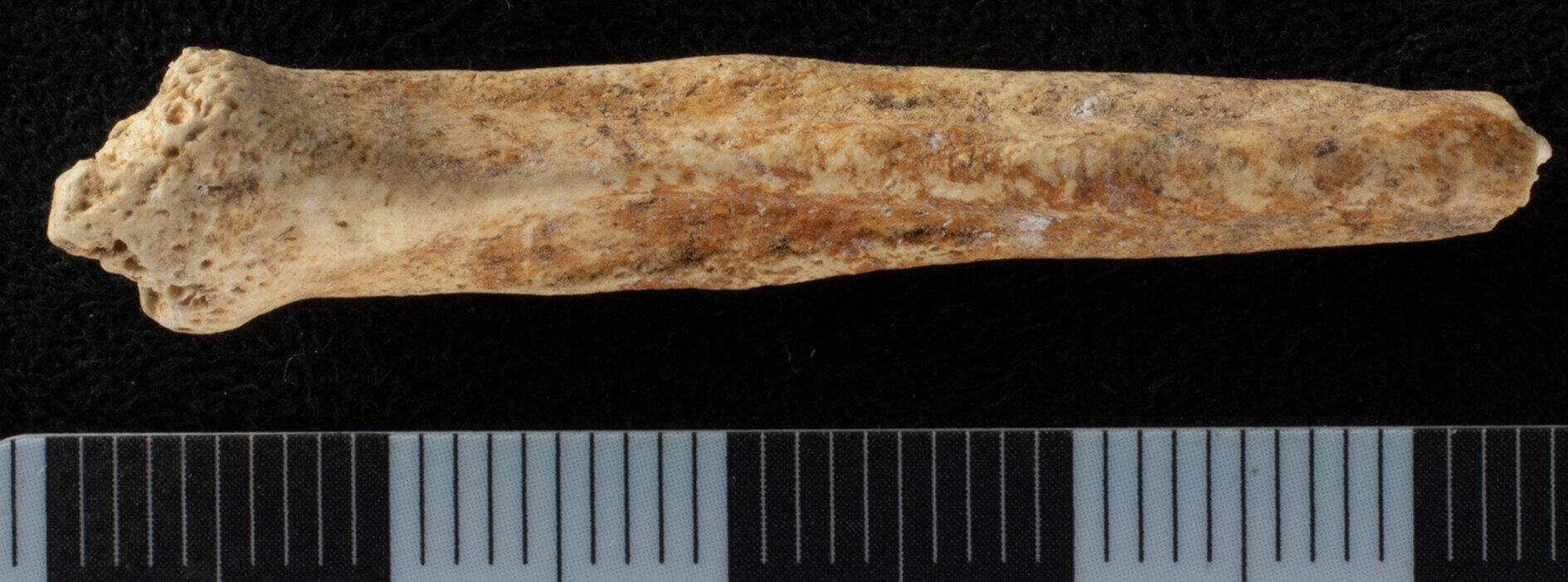In a fascinating discovery that sheds light on the rituals of ancient Roman society, a bioarchaeologist from the University of Reading, Ellen Green, uncovered a remarkable artifact: a red-painted canine baculum (penis bone) found among a collection of bones at an ancient Roman-era quarry shaft. This unique find, detailed in her paper published in the Oxford Journal of Archaeology, offers a glimpse into the cultural practices and beliefs of the time.
The excavation took place at a site known as Nescot, located near the modern town of Ewell in the U.K. The site had been a location of intense archaeological interest since 2015, when a group of archaeologists unearthed a four-meter-deep shaft that had been dug into the rock. As they continued to dig, they realized the shaft served as a type of grave, filled with hundreds of human and animal remains. What was initially seen as a standard archaeological site soon became something more intriguing as Green focused her attention on one particularly unusual object among the discovered bones.
The dog’s baculum, a bone found in the penis of many mammals, was painted with red ochre, a pigment commonly used in prehistoric and ancient rituals. The shaft itself contained remains of more than 280 domestic animals, with dogs representing a significant majority—about 70%. Interestingly, none of the animals showed signs of butchering, disease, or burning, which led Green to theorize that they had likely been pets or working animals that had died naturally and were buried in the shaft. However, it was the painted canine baculum that truly set this discovery apart.
Green’s study of the bones reveals that most of the animals buried in the shaft had been laid to rest in an unceremonious manner, with no obvious evidence of ritualistic treatment. The presence of the painted baculum, however, suggests that it may have had symbolic significance. During Roman times, representations of the penis, or fertility symbols, were often used in rituals associated with good luck, fertility, and protection. It is Green’s hypothesis that the red-painted canine baculum may have played a role in such a ritual—either before it was discarded into the shaft or during the act of burial.
Red ochre, known for its rich color and symbolic importance, was widely used in the ancient world. It was applied not only in burials but also in various rites and rituals. Its connection with fertility, life force, and protection makes it a plausible substance for use in objects associated with reproductive symbolism. Green suggests that the painted baculum could be linked to fertility rites, where the bone’s symbolic representation of virility might have been considered auspicious.
This shaft, used as a burial site for approximately 50 years, was added to at different times, perhaps on as many as nine separate occasions. Some bones appeared to have been removed at one point and then returned, raising questions about the rituals surrounding these burials. The repeated additions and alterations to the site suggest that the location was treated with care and respect, possibly for its association with spiritual or symbolic beliefs.
While Green acknowledges that it is impossible to definitively state the precise reasons the painted canine baculum was placed in the shaft, its discovery provides an invaluable piece of the puzzle in understanding Roman-era burial practices. It highlights the potential importance of animals, particularly dogs, in Roman society, not just as companions or workers but as active participants in religious and cultural practices. This bone, along with other finds in the shaft, hints at a deeper, perhaps more complex, layer of ritualistic behavior that we are only beginning to uncover.
The one-of-a-kind nature of this find is significant. There is no other known example of a painted canine baculum from this era, making it an extraordinary artifact in the field of bioarchaeology. It challenges our understanding of Roman practices and opens up new avenues for further research into the role of animals in ancient Roman religion and ritual.
In the broader context of archaeology, discoveries like this help us piece together the rituals and beliefs of ancient civilizations. They offer insights not just into their daily lives but into the symbolic and spiritual worlds they inhabited. The red-painted canine baculum found by Green stands as a striking example of how even the most seemingly ordinary objects can hold profound cultural and ritualistic significance, offering a window into the past that is both compelling and mysterious.
Ultimately, while the exact meaning and context of the painted bone remain speculative, it serves as a reminder of the intricate, and often surprising, ways in which humans have engaged with the world around them, imbuing the natural elements of life with meaning and significance. This discovery will no doubt continue to inspire scholars and researchers, offering a rare glimpse into the intersection of art, symbolism, and the spiritual practices of the ancient Roman world.
Reference: Ellen Green, Life from death: multi‐species fertility rituals within a Romano-British ritual shaft in southern England, Oxford Journal of Archaeology (2024). DOI: 10.1111/ojoa.12317
Think this is important? Spread the knowledge! Share now.
